Angara 1.2PP
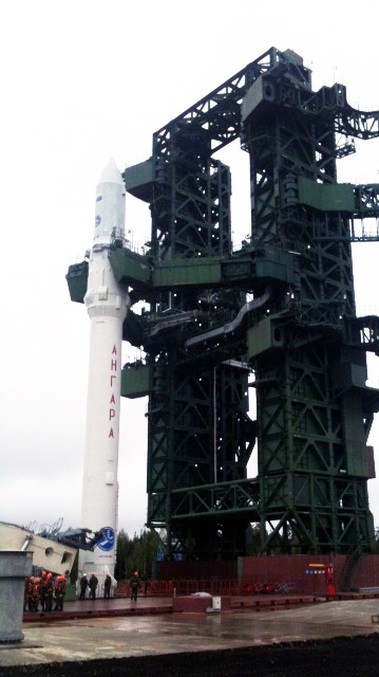
The Angara 1.2PP launch vehicle is a custom-version of the regular Angara 1.2 that will only be flown once – for the sub-orbital test launch of the Angara series in 2014.
Angara uses a modular approach to create a number of different launch vehicle versions with different payload capabilities. The concept is centered around the Universal Rocket Module that builds the core stage of the launcher and can also function as a strap-on booster similar to the U.S. Delta IV Heavy and Falcon Heavy rockets that use three cores.
Angara has been designed to use one (Angara 1.1 and 1.2), three (Angara 3), five (Angara A5) and seven cores (Angara A7) to create a range of launch vehicle options. Angara can fly as a two or three-stage launch vehicle. Different second and third stage options are being designed for Angara.
>>>Angara Launch Vehicle Family
Angara will be operated from the Plesetsk Cosmodrome and the Vostochny Cosmodrome that is currently under construction. A launch facility in Baikonur is also planned, primarily for launches of the Angara A5 vehicle, but the launch pad system for Angara can be used by all launcher versions except for Angara A7.
For its first test launch in 2014 from Plesetsk, Angara will fly in a configuration that will not be available as part of the operational Angara fleet since it has no application using an oversized second stage.
The purpose of the sub-orbital test flight of Angara is to demonstrate the Universal Rocket Module and its RD-191 engine in flight since it will be used across the entire launcher family. Secondly, the mission will certify the Universal Rocket Module-2, the second stage of the heavier Angara launchers, for its maiden mission on the Angara 5 launcher. In its operational configuration, Angara 1.2PP will revert back to a modified Block I diameter that is smaller in size than the URM-2.
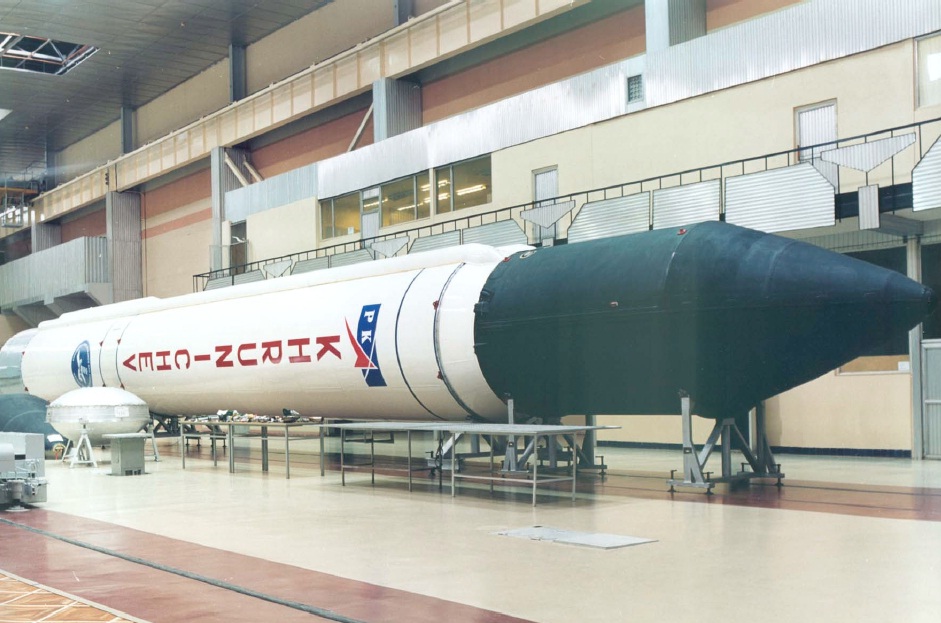
| Type | Angara 1.2PP |
| Length | 40.4m |
| Diameter | 2.9m |
| Launch Mass | <181,700kg |
| Stages | 2 |
| Boosters | 0 |
| Mass to Orbit | Only Sub-Orbital Test Launch |
Angara 1.2PP Specifications
Angara 1.2PP stands about 40.2 meters tall and has a Core Stage diameter of 2.9 meters at a launch mass of under 181,700 Kilograms. The vehicle consists of one Universal Rocket Module as first stage, powered by a single RD-191 engine, and a URM-2 second stage (modified Block I) using a four-chamber RD-0124A engine. The 1.2PP Angara borrows the payload fairing of the Rockot launch vehicle.
Universal Rocket Module & RD-191 Engine
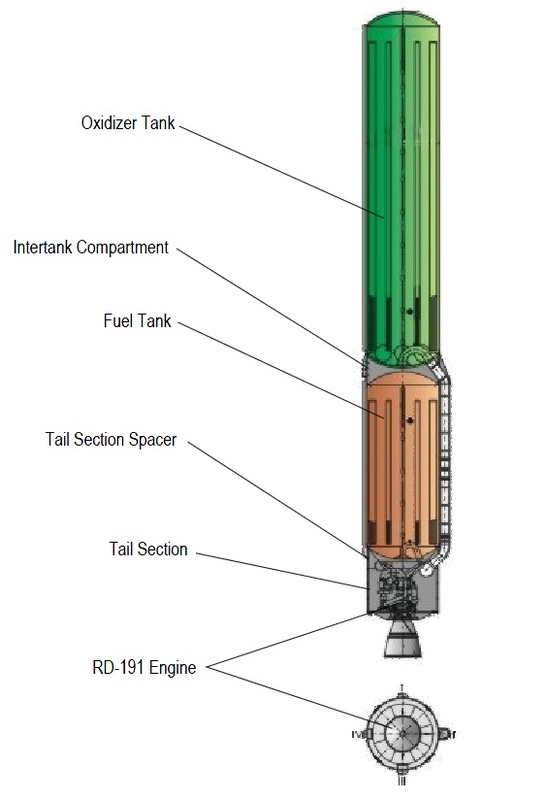
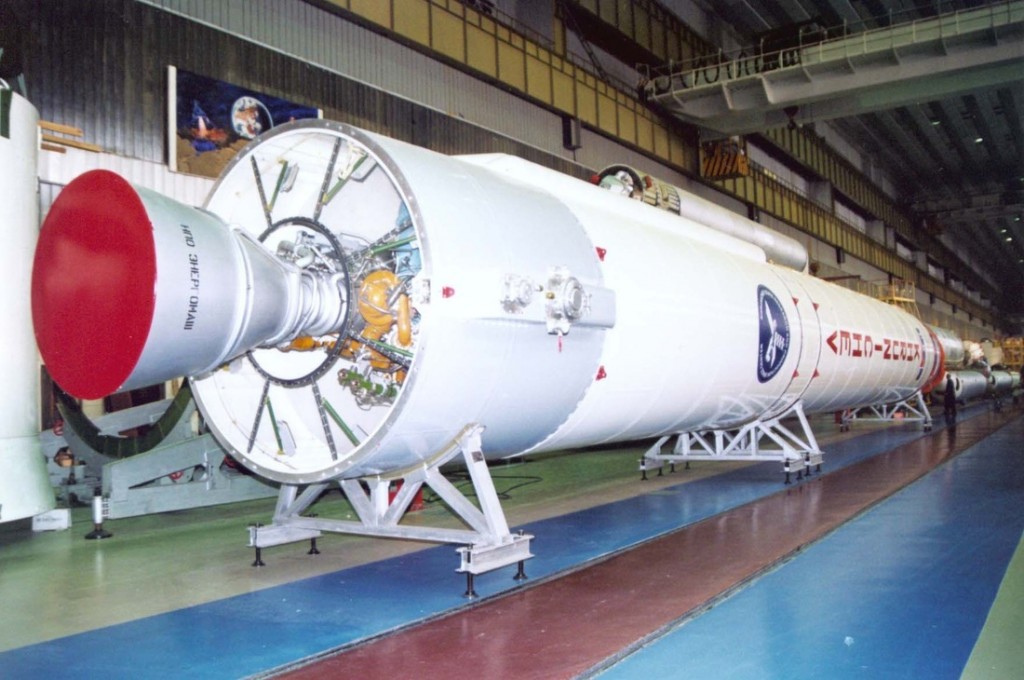
| Type | URM-1 (Universal Rocket Module) |
| Length | 25.695m |
| Diameter | 2.90m |
| Fuel | Kerosene (RP-1) |
| Oxidizer | Liquid Oxygen |
| Inert Mass | 9,800kg |
| Propellant Mass | 128,000kg (Partial Propellant Load) |
| Launch Mass | 137,800kg |
| Propellant Tanks | Aluminum Alloy, Intertank Section |
| Tank Pressurization | Helium |
| Propulsion | RD-191 |
| Engine Type | Staged Combustion |
| Thrust – Sea Level | 1,922kN |
| Thrust – Vacuum | 2,085kN |
| Specific Impulse SL | 311.4s |
| Specific Impulse Vac | 337.5s |
| Throttle Range | 27-105% |
| Mixture Ratio | 2.63 |
| Engine Diameter | 2.10m |
| Engine Length | 3.78m |
| Engine Dry Weight | 2,290kg |
| Engine filled Weight | 2,520kg |
| Chamber Pressure | 262.6bar |
| Burn Time | 240s |
| Guidance | Inertial |
| Pitch/Yaw Control | Hydraulic Engine Gimbaling +/-8° |
| Roll Control | 4 Nozzles & Control Surfaces |
| Engine Start | Pyrophoric TEA |
| Restart Capability | No |
| Stage Separation | Cold-Staging |
The Universal Rocket Module is common across the entire Angara family – it is used as Core Stage and can also function as a strap-on booster. Being the smallest of the family, Angara 1.2 uses only one URM acting as first stage. The URM is 25.7 meters long and 2.9 meters in diameter featuring the common structure with the oxidizer tank located above the fuel tank. The URM, when fully fueled, has a launch mass of 141,500 Kilograms with an empty mass of just under ten metric tons.
URM uses Liquid Oxygen as oxidizer and rocket-grade Kerosene fuel, stored in tanks consisting of hemispherical bulkheads and cylindrical sections. Aluminum alloy is used to manufacture the tanks and the URM uses composite materials in its interstage and instrument bay utilizing lessons learned from improvements of the Proton rocket that allow Angara to make use of production techniques creating light-weight components. The LOX feedline is routed on the exterior of the Kerosene tank to reach the engine compartment. The two tanks use individual bulkheads, creating an intertank area which is used to accommodate various instrumentation and control equipment.
Spherical Helium bottles are located inside the Liquid Oxygen tank to be submerged in LOX to improve gas storage efficiency. Helium is used for tank pressurization in flight, being heated up and fed to the tanks to keep them at the proper pressure levels. Helium loading begins once the bottles are submerged in Liquid Oxygen in order to be chilled down to accommodate the Helium.
The Universal Rocket Module is powered by a single RD-191 engine which is a one-chamber version of the RD-171 engine used on the Zenit rocket that is based on the RD-170 designed for the Energia rocket. The NPO Energomash RD-171 had already been converted to the two-chamber RD-180 currently used on the Atlas V launch vehicle. In the process of designing the RD-180, a study of creating a one-chamber version was conducted and the development of the engine was started in the late 1990s.
The first test firing was conducted in 2001 and the total testing program included 120 firings with a cumulative duration of 26,892 seconds. RD-191 completed its test program in 2011 and was certified in 2013 after another 18 firing tests.
Overall, RD-191 is 3.78 meters tall and has a nozzle diameter of 2.1 meters. The engine has an inert mass of 2,290 Kilograms. RD-191 is attached to the launcher via a gimbal truss and a spacer to the shell of the lower fuel tank.
RD-191 delivers a sea level thrust of 1,922 Kilonewtons (196,000kgf) with a specific impulse of 311 seconds. Thrust rises to 2,085kN (212,600kgf) in vacuum conditions with a vacuum impulse of 337.5 seconds. Through its design, RD-191 is capable of extremely deep throttling down to 27% of nominal performance. In flight, RD-191 will normally be throttled down no lower than 30%. The engine can also operate at 105% of rated performance for short periods of time which is utilized in contingency scenarios.
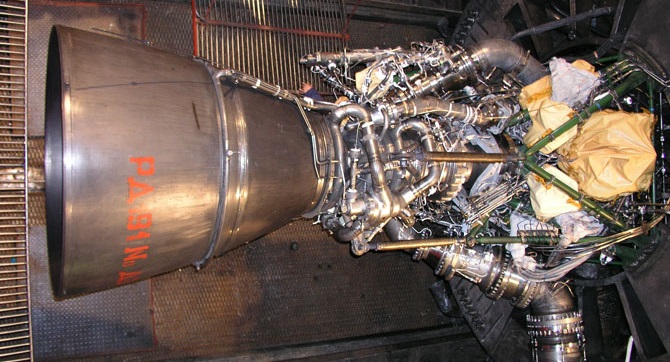
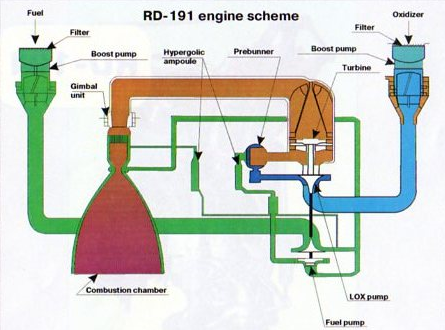
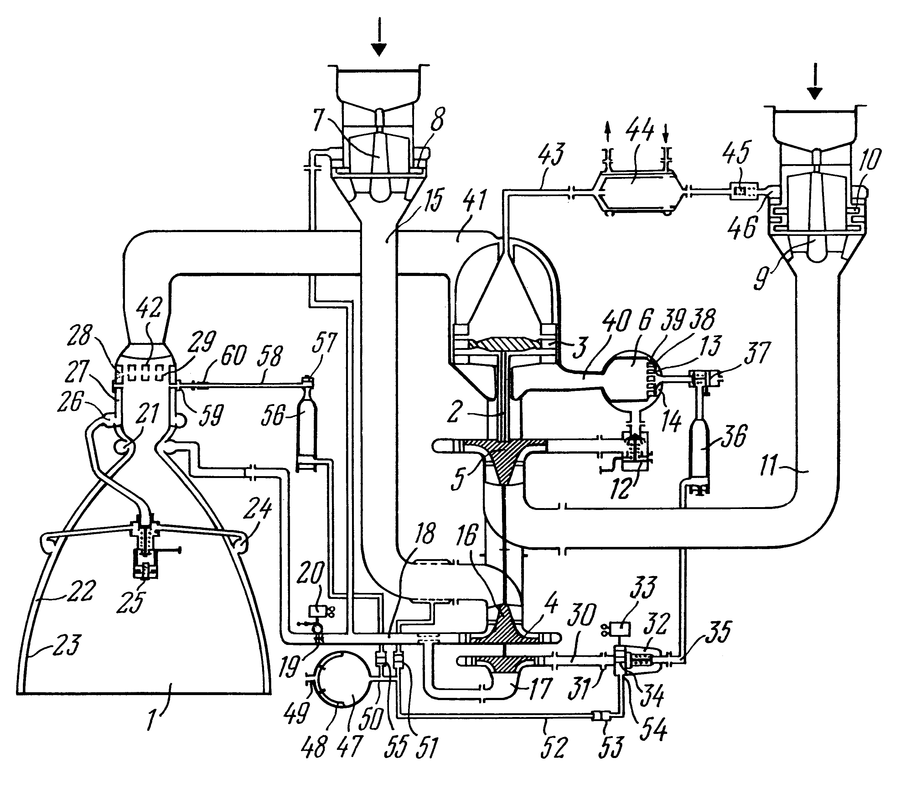
RD-191 uses a staged combustion scheme – burning all of the oxygen with little fuel inside a Gas Generator to produce a hot high-pressure gas to drive the turbine that powers the fuel and oxidizer turbopumps. The engine features boost pumps at the fuel and oxidizer inlets that operate at a lower speed than the main pumps and create an engine inlet pressure sufficient for the operation of the turbopumps. The fuel boost pump is powered by a turbine driven by the fuel tapoff from one main pump (fuel returns to the inlet) and the oxidizer boost pump turbine is driven by a fraction of the hot gas from the gas generator that then enters the LOX flow and condenses.
All of the oxygen is then directed to the LOX impeller turbopump before reaching the Gas Generator. The Kerosene flow is directed into two portions using a two-stage turbopump. The Kerosene flow from the second pump stage (about 20% of total flow) is directed into the Gas Generator were it is burned in an excess of oxidizer, creating a high-pressure, oxygen-rich gas that drives the turbine. The RD-191’s LOX turbopump and fuel pumps are mounted on a single shaft. The turbine itself is a axial turbine using relatively thick blades and large clearance between the gas inlet and the blades to reduce the risk of damage. Nickel-alloys are used to endure the hot temperatures of the gas from the generator and the turbine uses cold oxygen for additional cooling.
The Kerosene from the first stage pump is directed to the combustion chamber and nozzle where it passes through heat exchangers as part of the regenerative cooling scheme of the engine. The engine uses three cooling paths, one entering at the combustion chamber, one entering at the nozzle throat and the third one entering at the nozzle exit. After passing through the heat exchangers, the fuel is pumped into the combustion chamber where it is burned by the oxygen-rich gas coming from the gas generator. The mixture ratio is adjusted by a mixing valve located behind the first stage turbopump and the Gas Generator Temperature and engine thrust are regulated via flow valves ahead of the Gas Generator. RD-191 has a nominal mixture ratio of 2.63.
Regenerative Cooling Flow
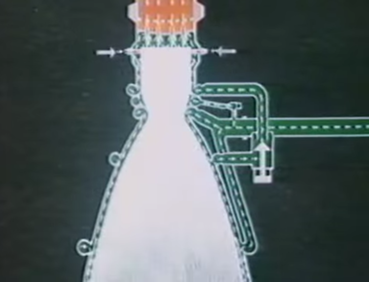
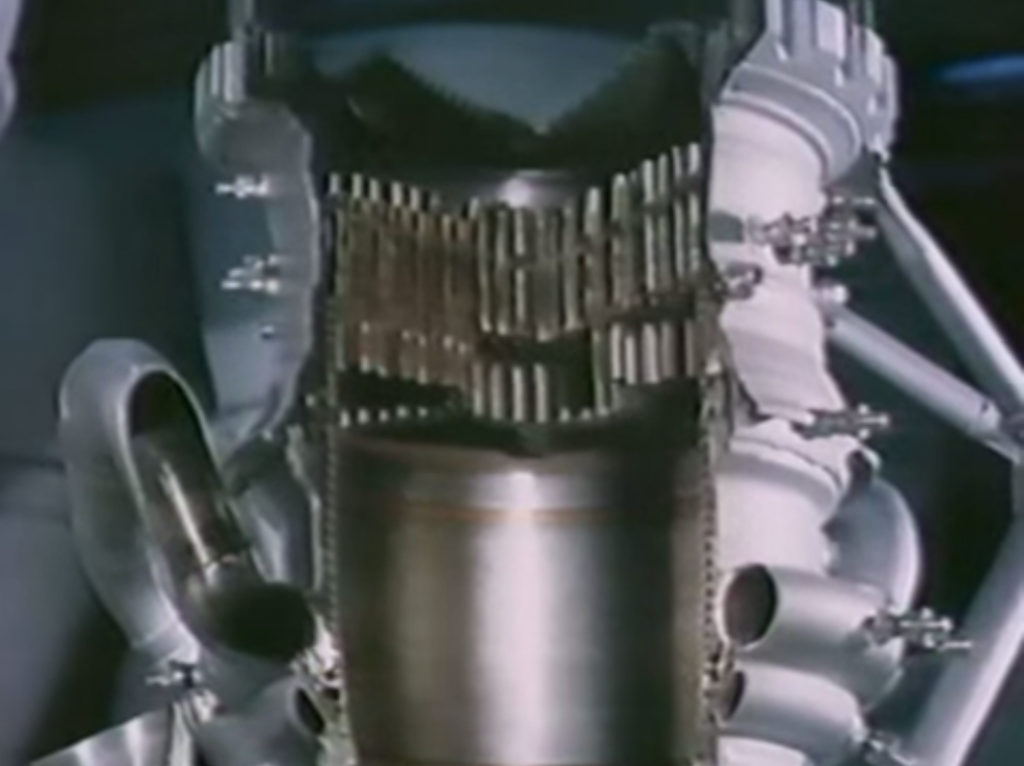
RD-191’s chamber consists of the mixing head, the combustion chamber and the nozzle. The injector uses small nozzles through which the components are introduced into the combustion chamber, forming a circular inner zone separated from an outer ring by protruding nozzles.
The outer ring is divided into six compartments using protruding nozzles through which propellants enter the chamber. Fuel and oxidizer-rich gas alternates between the seven compartments. This design allows a stable combustion and avoids combustion instability or the creation of hot spots. RD-191 operates at a nominal chamber pressure of 262.6 bar.
.
RD-191 Mixing Head & Chamber Design
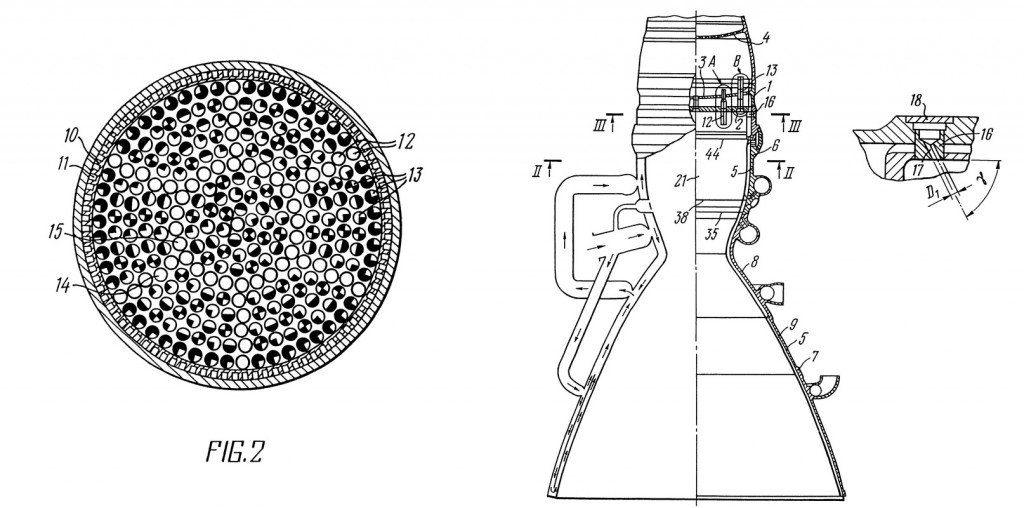
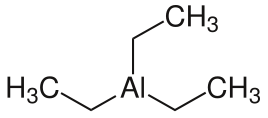
RD-191 uses a chemical ignition system based on Triethylaluminium (TEA) – a pyrophoric substance that immediately ignites upon exposure to oxygen. The TEA is stored in two closed ampoules – one in the fuel line directly ahead of the Gas Generator and one in the main fuel inlet to the combustion chamber. These ampoules use membranes to prevent the TEA from coming into contact with air.
For engine start, a dedicated spherical Kerosene, tank that is connected to both fuel lines via plumbing and associated valves, is filled with fuel and pressurized using high-pressure gas. Once the valves to the fuel lines and ampoules are opened, the high-pressure fuel drives pistons that are part of the ampoules to create a pressure inside the cavity that causes the TEA to be released into the Gas Generator and combustion chamber that have been filled with oxygen by that point after LOX valves are opened and the tank pressure causes oxygen to enter the engine.
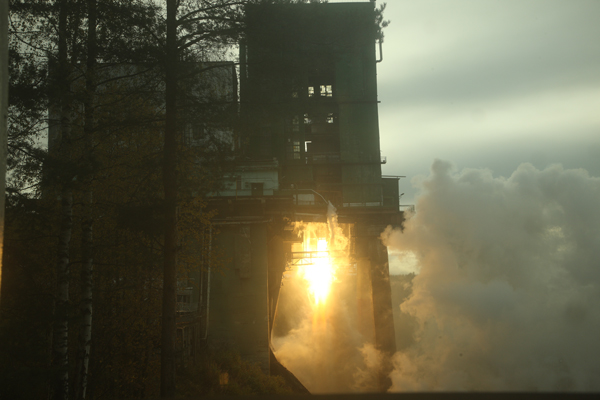
Coming into contact with oxygen, the TEA ignites and starts the combustion process inside the Gas Generator and the main chamber. The combustion is sustained by Kerosene entering the GG and combustion chamber right after the TEA. Once the Gas Generator is running, the turbine spins up to speed and the turbo and boost pumps begin pumping propellants to the Gas Generator and Combustion Chamber, thus sustaining the combustion process.
Using this ignition technique means that RD-191 can only be ignited once and requires extensive refurbishment after each ignition (replacing the TEA membranes and re-filling the ampoules).
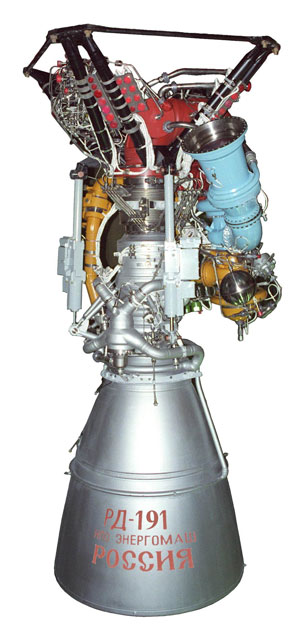
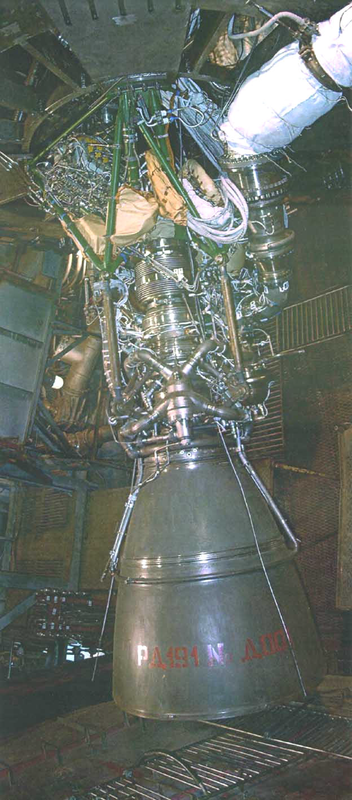
For tank pressurization, Helium flows from the Helium spheres inside the LOX tank down to the engine compartment where it is heated up inside a heat exchanger connected to the hot gas flow from the Gas Generator to the LOX Boost Pump. The pressurized heated Helium is then pressed into the LOX and Kerosene tanks to keep them at the proper pressure via a series of valves that control the pressurization. The initial pre-flight pressurization is accomplished using pressurized gas supplied by ground support equipment.
RD-191 uses a cardan suspension which allows it to gimbal +/-8 degrees using a hydraulic system driven by the gas generator exhaust. Engine gimbaling can only achieve control on the pitch and yaw axis requiring an additional system for roll control.
For that, hot has from the RD-191 gas generator is released through four nozzles onto two aerodynamic control surfaces that deflect the stream of hot gas and introduce a roll component depending on their position. The control surfaces on the outside of the tail section are moved using hydraulic pressure.
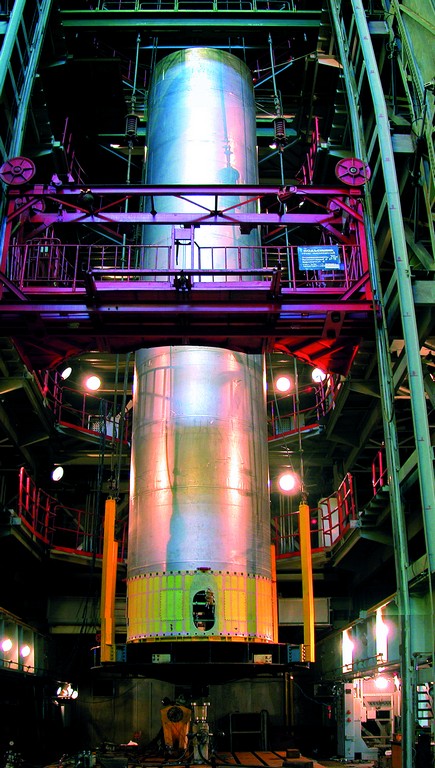
Being a modern engine, RD-191 includes various pressure, flow and temperature sensors that provide detailed performance data to the engine controller and flight computers. This allows a detailed monitoring of performance and extensive post flight analysis which can be useful in case of any anomalies. Also, telemetry is used in real time by the vehicle’s control system to adjust engine parameters like mixture ratio to optimize the performance of the launch vehicle via optimal propellant utilization. Additionally, engine telemetry is used to trigger launch vehicle abort modes.
The Universal Rocket Module houses control system devices, telemetry measurement systems, power supply units and batteries inside the intertank section. The URM control system is common across the entire Angara family and uses heritage components from the Proton-M and Briz-M vehicles. Functions of the URM control system include control of the engine, monitoring of propellant consumption, monitoring of vehicle health, engine gimbal control, control of aerodynamic surfaces and telemetry transmission to the ground.
The control equipment is self-contained and inertial using a modular structure that permits the addition of components at minimal difficulty. URM houses its own inertial guidance unit and also receives commands from the digital flight control system facilitated on the second stage.
Unlike the Soyuz, Angara uses a cold-separation sequence between the URM-1 and the second stage instead of the hot-staging of Soyuz in which the RD-0124 engine ignites before separation to be able to push the spent Core Stage away.
For staging on the Angara launcher, the RD-191 engine is shut down followed by a short delay before the pyrotechnic stage separation sequence is initiated, cutting the structural connection between URM-1 and the second stage. Next, four solid-fueled retrorockets are ignited on URM-1 located in the interstage area. These rockets move the Core Stage away from the second stage, clearing the way for engine ignition after a pre-programmed interval.
URM Tanks during Assembly

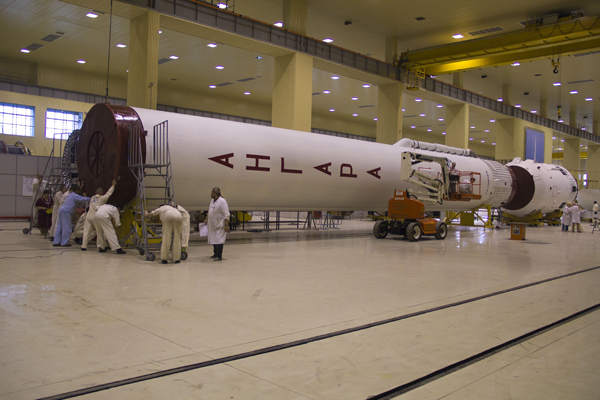
The interstage structure is separated with the first stage and stays attached to it, thus exposing the second stage’s engine compartment. Soyuz uses a three-segment aft section that is jettisoned ten seconds into the engine burn meaning that Angara eliminates one separation event, which are associated with some risk.
For Angara 1.2PP, the URM first stage launches with a partial propellant load of under 128 metric tons instead of its full load of 132.6 metric tons to achieve a reasonable initial thrust to weight ratio with the heavier second stage sitting atop. To achieve a liftoff similar to that of the operational Angara 1.2, the launch vehicle will likely target an initial thrust to weight ratio of 1.15. For the test mission, the second stage will likely feature a partial propellant load as well.
Second Stage – URM-2 & RD-0124A Engine

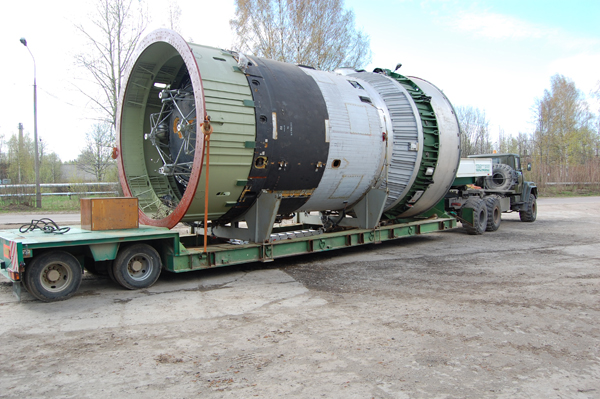
| Type | URM-2 – Modified Block I |
| Length | 6.87m |
| Diameter | 3.6m |
| Fuel | Kerosene (RP-1) |
| Oxidizer | Liquid Oxygen |
| Inert Mass | 4,000kg |
| Max LOX Mass | 25,100kg |
| Max Kerosene Mass | 10,700kg |
| Max Launch Mass | 39,800kg |
| Propellant Tanks | Aluminum Alloy with Intertank |
| Tank Pressurization | Helium |
| Propulsion | RD-0124A |
| Engine Type | Staged Combustion, Closed Cycle |
| Thrust – Vacuum | 294.3kN |
| Specific Impulse Vac | 359s |
| Engine Diameter | 2.400m |
| Engine Length | 1.575m |
| Engine Mass | 548kg |
| Thrust-to-Weight | 54.7 |
| Burn Time | 424s |
| Specific Impulse | 359s (Vac) |
| Chamber Pressure | 157bar |
| Restart Capability | No |
| Ox to Fuel Ratio | 2.34 |
| Turbine Temp. | 973K |
| LOX Flow Rate | 56.7kg/s |
| RP-1 Flow Rate | 23.9kg/s |
| Turbine Inlet | 319bar |
| Turbine Outlet | 185bar |
| Attitude Control | Chamber Gimbaling +/-3.5° |
| Shutdown | Commanded Shutdown |
The second stage of the Angara launch vehicle family is a modified Block I which, in its original configuration, is used on the Soyuz 2 rocket.
For Angara’s URM-2, the original diameter of the Block I is widened from 2.66 meters to 3.6 meters in order to significantly increase the propellant load of the stage by a factor of 1.4. In turn, the stage also grew about 13 centimeters in length due to the use of different bulkhead shapes on the propellant tanks.
Measuring 3.6 meters in diameter, the URM-2 second stage is wider than the URM-1 first stage of the Angara 1.2 launch vehicle. The mass of this fully fueled second stage would be too much to handle for the RD-191 engine of the first stage which would not reach a sufficient thrust to weight ratio at liftoff.
Originally, it was planned to launch Angara 1.2 with a reduced fuel load of 25,700kg on the second stage, but in 2009 the design was changed – introducing a different modification of the Block I only for the light-lift Angara 1.2 which would keep the basic Block I dimensions, but use the RD-0124A engine and Angara control systems.
For the sub-orbital test launch, Angara 1.2PP will fly in its original design with the larger URM-2 stage to certify it for later flights on the Angara A5 rocket.
The Universal Rocket Module-2 is 6.87 meters long and 3.6 meters in diameter with an empty mass of approximately 4,000 Kilograms. It is comprised of two tank compartments to facilitate the fuel & oxidizer tanks, an intertank section and a propulsion section in the aft of the stage where the RD-0124 engine resides. Overall, the stage can be filled with up to 35,800 Kilograms of propellants for a total launch mass of close to 40 metric tons.
URM-2 uses aluminum alloy tanks – the lower tank facilitates 25,100 Kilograms of Liquid Oxygen using two hemispherical bulkheads with a cylindrical section in between, the Kerosene tank above the LOX tank holds 10,700 Kilograms of fuel consisting of two hemispherical bulkheads with a very small cylindrical section. The Kerosene feedline runs from the fuel tank down the outside of the LOX tank to reach the engine compartment.
Using separate bulkheads, the tanks have a small intertank section between them that is used to house the flight computers and various control equipment. The conventional Block I uses a three-segment aft structure to protect the upper engine compartment portion and a part of the thrust structure and LOX tank during atmospheric flight. URM-2 uses an interstage adapter that narrows in diameter in order to fit onto the 2.9-meter first stage. During stage separation, the entire interstage separates to expose the engine compartment of URM-2 making any aft cover jettison obsolete.
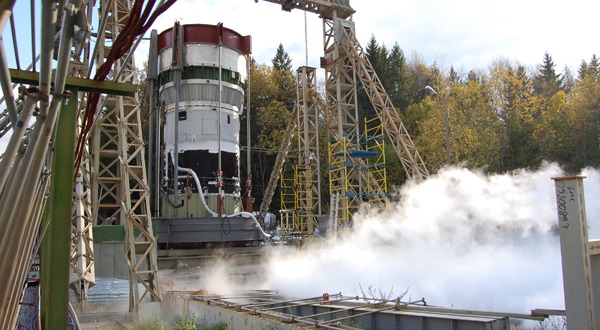
The URM-2 stage is powered by an RD-0124A engine which is essentially an RD-0124 from the Soyuz with two modifications – it uses a different structural design with a reduced number of components and lighter materials, reducing the overall weight of the engine by 24 Kilograms and improving its thrust to weight ratio. The second difference is the certification of the engine for a longer burn time than that of the Soyuz. This change comes into play because Angara uses larger URM-2/Block I stage with more propellants requiring the engine to burn up to 424 seconds.
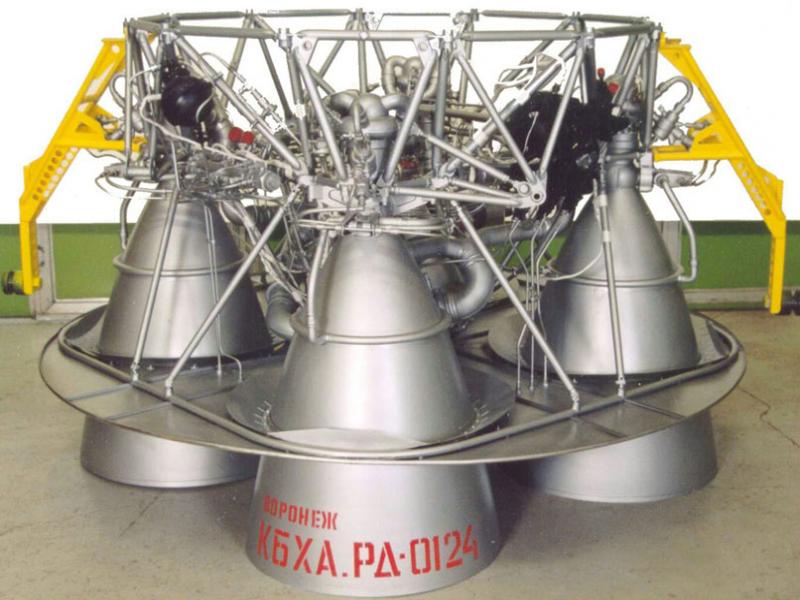
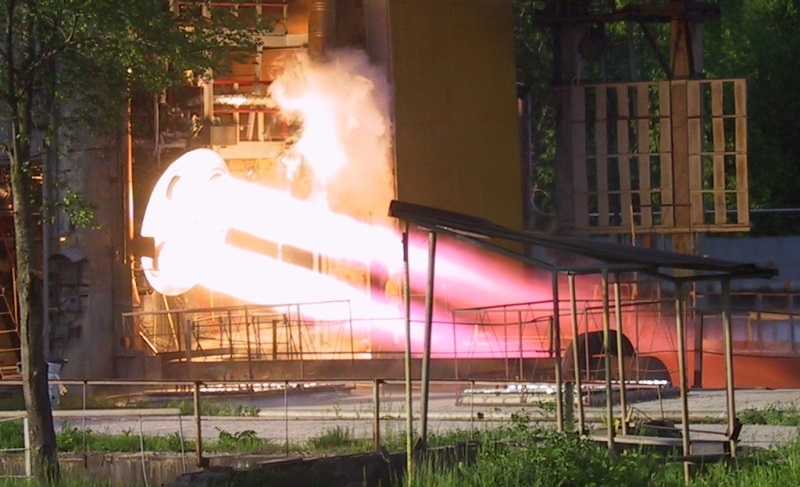
The RD-0124A is a four-chamber engine with a single Gas Generator and turbopump assembly supplying all combustion chambers. This engine is derived from the RD-0110, but is a closed-cycle gas-generator type engine. Overall, RD-0124A is 2.4 meters in diameter and 1.58 meters tall with an empty mass of 548 Kilograms. The engine delivers a thrust of 294.3 Kilonewtons (30,400kgf) and has a specific impulse of 359 seconds – a major improvement over the RD-0110 due to the use of a closed cycle and the higher chamber pressure of that design.
The RD-0124A uses a typical staged combustion cycle of Russian engines with an Oxygen-rich gas generator in which the entire LOX flow is combusted with a small portion of the fuel flow to create a hot high-pressure gas to drive the turbine of the engine which powers the turbopumps. The rest of the Kerosene is used for cooling of the chambers before being injected into the combustion chambers and burned with the oxygen-rich gas.
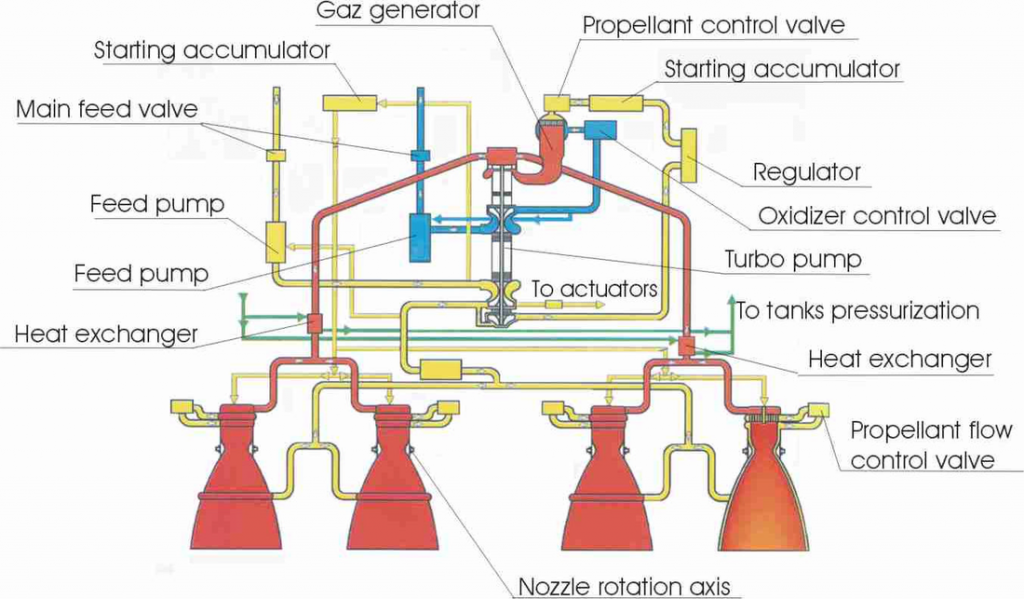
Propellants entering the engine are pumped to the main turbopumps by separate boost pumps in the Kerosene and LOX lines needed to reach the proper inlet pressure of the main pumps. The turbo-axial boost pumps are similar in design – each unit includes one rotating part that consists of axial pump wheels and a hydraulic turbine, brazed or welded onto the pump wheel external diameter. The boost pump of the fuel inlet is driven by the high-pressure tapoff from the second stage Kerosene turbopump that re-enters the propellant inflow after passing through the turbine. On the LOX side, the boost pump turbine uses a similar scheme – it is powered by a fraction of LOX from the turbopump that also re-enters the feedline.
RD-0124A uses a single shaft to which the LOX turbopump and a two-stage Kerosene turbopump are mounted. The shaft is driven by a turbine powered by the high-pressure gas produced by the Gas Generator.
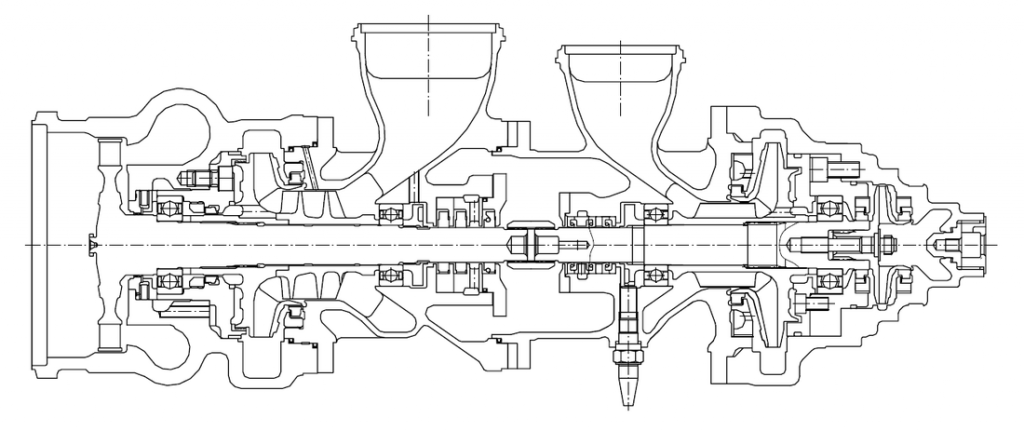
The turbopump housings and impellers are castings made from stainless steel. The impeller seals use bronze floating rings and the pump rotors employ a thrust balance system to ensure a proper axial balance. Both pumps use their respective propellants to lubricate and cool the turbopump ball bearings. The LOX turbopump operates at an inlet pressure of around 3 bar and an outlet pressure of 363 bar at a LOX mass flowrate of 56.7 Kilograms per second. For the Kerosene pump, inlet pressures of under 2 bar are sufficient to allow the pump to generate an outlet pressure of 366 bar at a flowrate of 23.9kg/sec.
The entire LOX flow from the turbopump is passed through an oxidizer control valve to the Gas Generator where it combusts the Kerosene supplied by the second stage of the turbopump via a propellant control valve and a regulator that adjusts the mixture ratio that is normally set at 2.34. The Gas Generator produces a hot gas (973K) entering the turbine at a pressure of 319 bar and a flowrate of 59.85 Kilograms per second. Spinning the turbine at 39,000 rpm, the hot gas exits at a pressure of 185 bar, being directed on two paths that are then further separated into four lines to feed the four combustion chambers.
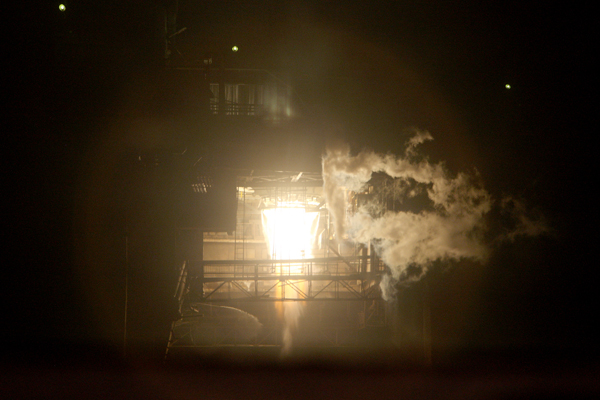
While still at the two-line stage, the hot gas passes through heat exchangers to warm up the Helium gas supply for tank pressurization. Helium is stored in five spherical tanks submerged in the LOX tank and supplied to the engine to be heated up and pressurized in order to be able to pressurize the Kerosene and LOX tank via a number of pressure regulators and valves that ensure proper pressure levels are maintained.
The Kerosene from the first stage turbopump is directed to the combustion chambers where it is used to cool the chambers and nozzles as part of two circuits per engine chamber. Afterwards, the Kerosene enters the combustion chambers where it is burned by the oxygen-rich gas generator gas supply. The chambers use a mixing head for a stable combustion process and operate at a nominal chamber pressure of 157 bar.
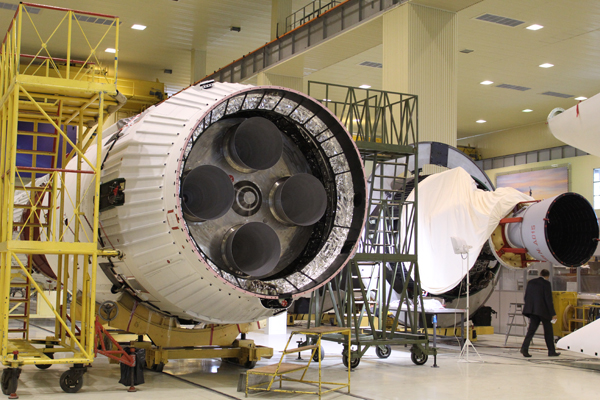
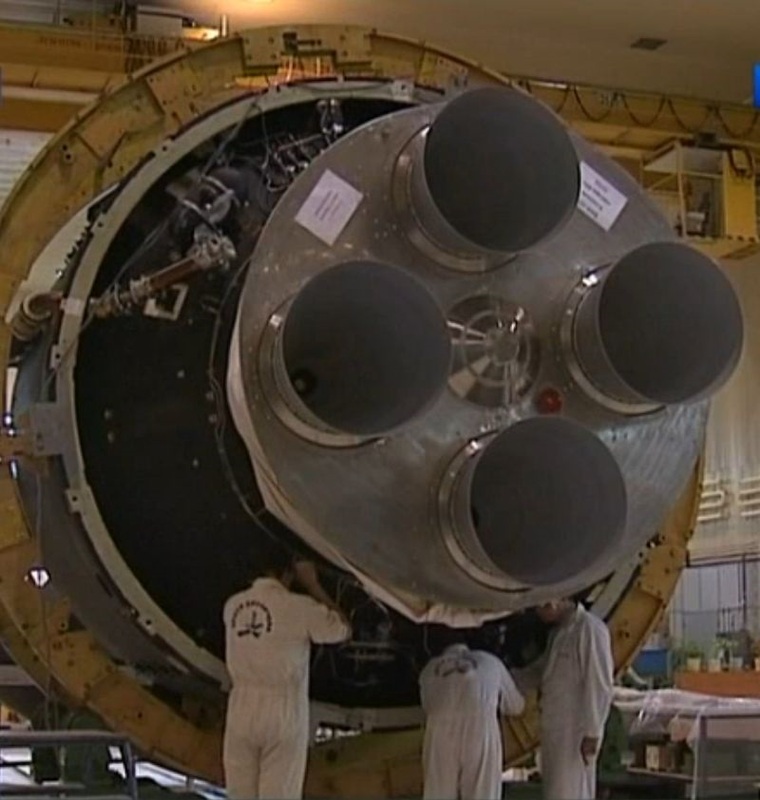
Engine ignition is accomplished by injecting a pyrophoric substance into the Gas Generator and the four chambers that ignites when coming into contact with the oxygen. Once started, the combustion process is sustained by injecting the Kerosene into the GG and combustion chamber. As the gas generator starts spinning the turbine, the turbopumps begin supplying propellants to the Gas Generator and chambers to continue the combustion process. The pyrophoric igniter fluid is stored in accumulators just ahead of the Gas Generator and the chambers that release the fluid once the Kerosene pressure is sufficient to break the membranes.
A small fraction of the Kerosene flow from the first turbopump stage is used to drive the hydraulic actuators of the engine that allow each chamber of be moved by +/-3.5 degrees in one direction. With four chambers being able to move along different directions, attitude control in pitch, yaw and roll can be accomplished. Following payload separation, the Block I stage uses a reaction nozzle that vents the oxygen tank in order to move away from the separated spacecraft.
Angara uses a triple-redundant digital flight computer sharing a lot of commonality with the Proton launch vehicle. The control system features a digital onboard computer providing all vehicle commanding and guidance is provided by a 3-axis Inertial Measurement Unit.
The control equipment provides vehicle control, telemetry and navigation for the entire flight and issues all vehicle commands autonomously. The equipment is located in the area between the two propellant tanks inside a small equipment bay. The guidance mode used is closed-loop. A high-precision three-axis gyro stabilizer provides exact attitude data to the digital flight computer and the avionics system also provides flight termination in case of a major anomaly during ascent.
Payload Fairing
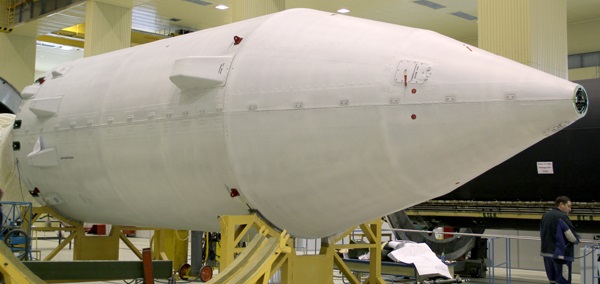
| Fairing 1 | Rockot |
| Length | 7.8m |
| Diameter | 2.5 by 2.62m |
| Mass | ~500kg |
| Structure | Honeycomb Aluminum Core |
| Graphite enforced Facesheets | |
| Separation | Mech. Locks, Pneumatic, Pushers |
Angara 1.2PP uses a fairing that is a copy of that of the Rockot launcher modified to fit the URM-2 second stage of the launcher.
The two fairing halves of Rockot are 7.8 meters in length and when joined have an elliptical shape that is 2.5 by 2.62 meters in diameter. Structurally, the fairing is comprised of a honeycomb aluminum core with graphite enforced facesheets. The usable payload envelope is 5.9 meters tall.
When the launcher has left the atmosphere, the fairing is jettisoned by releasing mechanical locks that are holding the two half-shells together along the vertical split line via a pyrotechnic device located in the nose of the fairing. Following lock release, several pyrobolts on the horizontal split line are fired to enable the fairing to be moved sideward by spring pushers. Hinges on the fairing base ensure outward rotation and clean separation of the fairing.
